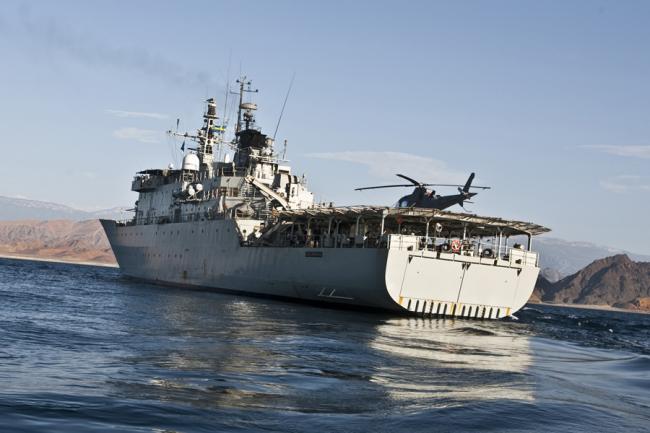As part of EU NAVFOR's more offensive tactics some units are now and then tasked to operate close to the Somali shore. Recently the Flag ship HSwHMS CARLSKRONA was given this task. When passing two hijacked merchant ships the pirates suddenly called on the radio and warned the Swedish warship it was getting too close.
On Sunday the 25 of July HSwMS CARLSKRONA was searching after pirate-related activities near the Somali coast. The landscape is beautiful and varies from the gigantic mountains that plunge steeply into the sea to the more flat areas with sandy beaches. Carlskrona was tasked for ISR – Intelligence, surveillance and reconnaissance – photographing boats, buildings and activities on the beach. The boarding team was out in the RHIB (a fast ships-boat) talking to local fishermen, in order to get up-to-date information on activities in the area.
EU NAVFOR Flag ship CARLSKRONA passed the two hijacked merchant vessels Motivator and Golden Blessing, at anchorage close to one another. MV Golden Blessing was hijacked on 28 of June in the Gulf of Aden and MV Motivator was hijacked on the 4 of July in the southern Red Sea.
Although increasingly effective at preventing pirate attacks EUNAVFOR warships are limited in their ability to intervene after a vessel has been hijacked for fear of harming the hostages. When the ships are hijacked and anchored we also stop communicating with them in order not to interfere with the communication between the owner of the ship and the pirates.
Despite the fact that we passed the ships at an appropriate distance the pirates aboard the hijacked vessels reacted strongly to our presence. The hijackers did not want us getting closer. They warned us, by radio, and demanded that CARLSKRONA leave the area.
“With regard to the hostages' safety on board, we can not do much more than document the vessels and their positions. It is frustrating to be so close and yet not be able to help the ships' crews”, said Commanding Officer Håkan Nilsson, continuing that;
“What is important in this context is not only that two ships with their cargo have been hijacked, the biggest tragedy is that the crews, who are now hostages, and their families, are the ones who will pay the highest price for this crime.”
It is not unusual for it to take up to six months of negotiations before the vessels are released. There are currently 348 crew members hostage on a total of 16 hijacked ships anchored at various locations off the Somali coast.
EU NAVFOR Somalia – Operation ATALANTA’s main tasks are to escort merchant vessels carrying humanitarian aid of the World Food Programme (WFP) and vessels of African Union Mission in Somalia, AMISOM and to protect vulnerable vessels in the Gulf of Aden and Indian Ocean and to deter and disrupt piracy. EU NAVFOR also monitors fishing activity off the coast of Somalia.
On Sunday the 25 of July HSwMS CARLSKRONA was searching after pirate-related activities near the Somali coast. The landscape is beautiful and varies from the gigantic mountains that plunge steeply into the sea to the more flat areas with sandy beaches. Carlskrona was tasked for ISR – Intelligence, surveillance and reconnaissance – photographing boats, buildings and activities on the beach. The boarding team was out in the RHIB (a fast ships-boat) talking to local fishermen, in order to get up-to-date information on activities in the area.
EU NAVFOR Flag ship CARLSKRONA passed the two hijacked merchant vessels Motivator and Golden Blessing, at anchorage close to one another. MV Golden Blessing was hijacked on 28 of June in the Gulf of Aden and MV Motivator was hijacked on the 4 of July in the southern Red Sea.
Although increasingly effective at preventing pirate attacks EUNAVFOR warships are limited in their ability to intervene after a vessel has been hijacked for fear of harming the hostages. When the ships are hijacked and anchored we also stop communicating with them in order not to interfere with the communication between the owner of the ship and the pirates.
Despite the fact that we passed the ships at an appropriate distance the pirates aboard the hijacked vessels reacted strongly to our presence. The hijackers did not want us getting closer. They warned us, by radio, and demanded that CARLSKRONA leave the area.
“With regard to the hostages' safety on board, we can not do much more than document the vessels and their positions. It is frustrating to be so close and yet not be able to help the ships' crews”, said Commanding Officer Håkan Nilsson, continuing that;
“What is important in this context is not only that two ships with their cargo have been hijacked, the biggest tragedy is that the crews, who are now hostages, and their families, are the ones who will pay the highest price for this crime.”
It is not unusual for it to take up to six months of negotiations before the vessels are released. There are currently 348 crew members hostage on a total of 16 hijacked ships anchored at various locations off the Somali coast.
EU NAVFOR Somalia – Operation ATALANTA’s main tasks are to escort merchant vessels carrying humanitarian aid of the World Food Programme (WFP) and vessels of African Union Mission in Somalia, AMISOM and to protect vulnerable vessels in the Gulf of Aden and Indian Ocean and to deter and disrupt piracy. EU NAVFOR also monitors fishing activity off the coast of Somalia.
